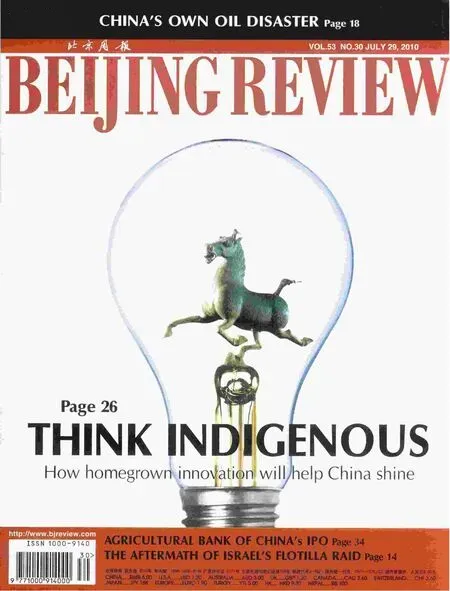China’s Path Toward Innovation
2010-03-15

China outlined the indigenous innovation strategy in its National Medium- and Long-term Science and Technology Development Plan (2006-20) four years ago. What is the main goal of the strategy and how has it been progressing? What are the Central Government’s support policies and what efforts are still needed? Are there any barriers hindering the development of indigenous innovation in the country?Gao Xudong, a senior researcher with the Research Center for Technological Innovation at Tsinghua University sat down with Beijing Review reporter Lan Xinzhen to share his opinions.Edited excerpts follow∶
Beijing Review: What is the main goal of China’s indigenous innovation strategy?
Gao Xudong: Ultimately, China wants to help domestic enterprises engaged in fi erce competition with foreign counterparts succeed in the global marketplace. By improving its innovation capability, the country is set to develop cutting-edge technologies and advanced products with its own intellectual property rights (IPRs). The vigorous efforts that indigenous innovation requires in terms of R&D will help China acquire the new knowledge and technologies to move ahead with the strategy.
What was annoying the country when it decided to launch the strategy?
For several decades, China introduced a number of foreign technologies to propel domestic economic development. Many domestic appliance-makers, for example,have enjoyed global recognition as they gain a competitive edge by taking advantage of foreign technologies.
But the dynamics have changed since China entered the WTO in 2001. Many multinationals now see Chinese enterprises as growing competitors, and have tried to make it more dif fi cult for Chinese rivals to acquire technologies from overseas.
Most Chinese companies are also latecomers to the international market, and fi nd it excruciatingly difficult to compete with the older, more experienced foreign giants.Some Chinese companies even face the risk of being marginalized due to a lack of core technologies. This risk was barely felt in the past, but now casts an ominous shadow over prospects for Chinese businesses.
That’s why it is urgent now for domestic companies to form their own team of researchers and grab core technologies to sharpen their competitive edge. It’s also the only viable solution for Chinese enterprises competing internationally.
How is the innovation strategy progressing? What are the Central Government’s support policies?
Strategies to make China into an innovative nation were outlined at the National Science and Technology Conference in early 2006. The Central Government later announced the National Mediumand Long-term Science and Technology Development Plan (2006-20), with the intention to create a business environment conducive for enterprises to take the initiative in technological innovation. The government has since handed out an array of policy incentives in 10 areas, including R&D funding, tax breaks, financial support, government purchases, foreign technology acquisition and assimilation,talent pool management, IPR protection and policy coordination.
There are opinions that the market, instead of the government, should play a larger role in promoting indigenous innovation in a market economy, and that too much government intervention will violate WTO rules. But I think these opinions are totally unfounded. The government should play an active role in promoting innovation with unwavering support. In this way, enterprises will realize the importance of developing their own core technologies; and it will help boost their con fi dence, mobilize more investment and encourage them to innovate effectively.
The Chinese Government can take numerous steps to foster a better environment for indigenous innovation.
First, policies should be adjusted to encourage acquisition of only truly advanced technologies, while discouraging imports of technologies China is capable of developing.
Second, the government should support research institutes, universities and a few leading enterprises to make breakthroughs in R&D of key technologies.
Third, efforts must be made to cultivate the market for homegrown technologies and products. While opening the market to foreign investors and products, we have to make sure such moves will not mar the competitiveness of domestic enterprises. While fulfilling China’s WTO commitments, we should cancel preferential policies for foreign companies, especially those directly competing with Chinese enterprises in the Chinese market.
What substantial measures must China take to beef up indigenous innovation?

INNOVATIONINCUBATOR:An exhibition on indigenous innovation achievements waskicked off inTsinghua Science Park in Beijing’s Haidian Districton September12, 2006. Thepark is backedby a talent pool of students andresearchersfrom universities and institutes
Many Chinese enterprises have been successful in developing their own technologies. The success was attained largely because of their down-to-earth attitude and ceaseless experiments. During the process,they built con fi dence and came up with new research methods.
The government should kick off largescale R&D efforts to develop China’s own core technologies as soon as possible, and pump heavy investments into such projects.
Compared with multinationals, Chinese enterprises are less competitive in original innovations. It would be wise for them to begin indigenous innovations with knowledge-intensive and less time- and capitaldemanding technologies.
Moreover, large numbers of highly competent scientists and engineers are needed to guarantee the success of the national innovation campaign. Enterprises have to closely cooperate with research institutes, particularly at the initial stage of indigenous innovation, because researchers have always worked in institutes and universities in China and a majority of Chinese enterprises don’t have competent enough teams for independent technological innovations.
Chinese companies also face certain obstacles as the newcomers to the innovation scene.Even if they make breakthroughs in developing core technologies, it’s usually very dif fi cult for Chinese brands to market their technologies or products in markets already dominated by multinationals. It’s a general phenomenon that consumer goods and industrial product markets favor established multinational corporations against newcomers.
What are the most pressing issues facing China in the development of innovation?
There are three major barriers hindering the development of China’s indigenous innovation.
First, there is a general lack of awareness in the country about the urgency of indigenous innovation. Some people still believe Chinese companies are not yet capable of developing their own technologies, which can be costly and risky to pursue. They insist that technology imports are safer and Chinese companies should continue with low-cost production to compete with foreign rivals. Some even believe that there is no need for indigenous innovation since foreign companies can generate tax revenues and boost local employment as well.
Second, many people have little confidence in indigenous innovation. They tend to overestimate the technological advantages and market dominance of foreign companies and have doubts about whether Chinese enterprises can successfully complete research projects. Some people even think indigenous innovation must be started with technology introduction from abroad. In fact, many Chinese enterprises—joint ventures, in particular—still rely on their overseas partners to improve their technology prowess.
Third, Chinese companies lack effective measures and strategies of how to proceed with indigenous innovation and seldom take the initiative to strengthen R&D.
How should China coordinate indigenous innovation and technology transfers?
Promoting indigenous innovation does not mean China has to completely give up technology imports. Instead, it would remain an important channel for China to acquire advanced technologies from overseas.
Of course, the country has a reason to properly arrange the two aspects. There are three principles to follow given different circumstances∶
When multinationals find it difficult to turn their technological strengths into real competitive advantages in the Chinese market and Chinese companies have opportunities to attain technological resources and improve their technological capacities, Chinese companies can either acquire overseas technologies or build up their own innovation capabilities.
Or, if difficulties for multinationals remain the same and Chinese companies face shortfalls in attaining technological resources or improving their technological capacities,Chinese companies should count more on acquired technologies rather than on indigenous innovation.
But when multinationals face few barriers in turning their technological strengths into real competitive advantages in the Chinese market, and Chinese have opportunities to attain technological resources and improve their technological capacities,Chinese enterprises should develop their own innovation capabilities. ■
By improving its innovation capability, the country is set to develop cutting-edge technologies and advanced products with its own intellectual property
rights
